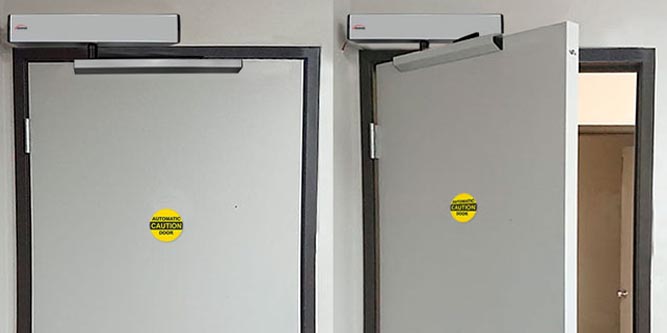If you run a business, you want it to be as accessible as possible to the general public. One of the biggest sticking points is doors. For individuals with some disabilities, using a traditional doorknob or handle can be difficult or impossible. Not only that, but people might need to get through while their hands are full. Or they may need to get through the door with dollies and other equipment. In these types of situations, an automatic electronic door opener can make a huge difference. To be clear, we’re not talking about big, garage door keypad openers. We’re talking about the smaller openers used for ordinary interior doors.
That said, these doors come in a variety of types, and they all have different capabilities. When you’re choosing your door opener, you want the one that’s right for your situation. For example, do you need it to primarily work as a closer or an opener? How heavy is your door? How long do you want it to stay open? And how do you want the controls to work? These and other questions will impact the type of electric door opener you buy. For this reason, it’s important to do your research before you install one. Otherwise, you could end up with a door opener that’s wrong for your situation.
We’re about to review two of the best automatic electric swing door openers with button controls. To start out, we’ll look at the Olide-120B Automatic Door Operator. This is a versatile door opener that can be mounted on either an inswing or an outswing door. After that, we’ll examine the Visionis VIS-7337 Slim. This is a slightly more compact door opener with an optional touchless control button. But which one is going to be the ideal choice for your home or business? To answer that question, we’re going to have to take a much closer look at both of them. After that, we’ll be in a better position to make a comparison. Let’s get started, and see what we discover!
Automatic Door Opener Basics
Before we talk about these two door openers, let’s discuss the basics. What makes one interior electric door opener different from another? To begin with, they fall into two broad categories: electro-hydraulic and electro-mechanical. Technically, both types are capable of opening your door when needed. The main question is how often they’re going to be used for that purpose.
An electro-hydraulic opener is primarily designed for manually use. It contains a hydraulic closer, which causes the door to shut gently when someone lets go of it. It’s designed more to protect your door and frame from slamming than for opening the door. That said, there’s a built-in mechanical motor that can open the door when needed. So if it only occasionally needs to be opened mechanically, you’ll be just fine.
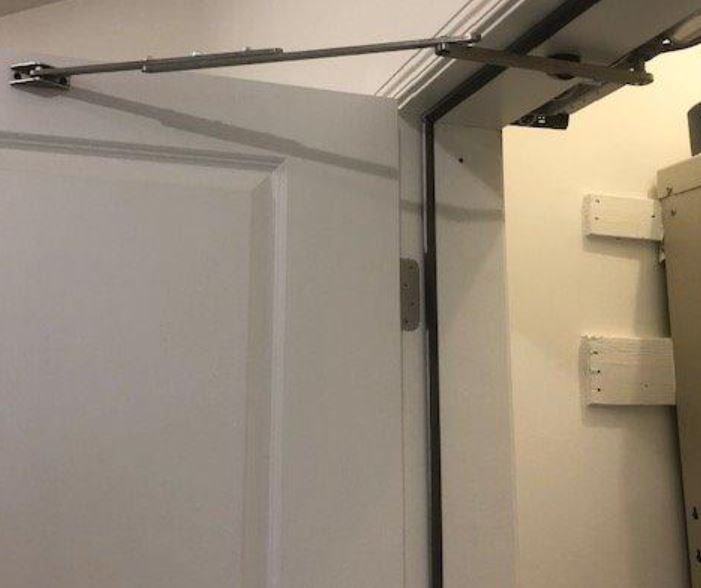
Electro-mechanical openers, on the other hand, are built for doors that primarily open automatically. Instead of using a hydraulic motor for closure, the mechanical motor works in both directions. The motors also tend to be more robust, which means they’re more durable. By contrast, electro-hydraulic openers will tend to fail if the motors are overused. For this reason, both of the door openers we chose today have an electro-mechanical design.
Another important consideration is how the door is going to be activated. Different methods have their own benefits. For example, a lot of retail stores use motion-sensing activators for their customers’ convenience. But in a home or office environment, this can get annoying. You don’t necessarily want the door to open every time someone walks past. In that case, a button-activated door opener makes more sense. There are also hands-free options, where you wave your hand in front of a sensor. And if you want remote activation, you can even choose a door with wireless control fobs. Automatic door openers should also not prevent the door from being opened manually. That way, people won’t get locked in when the power goes out.
You’ll also want to think about how the door is secured. In most cases, your door is going to have a latch of some kind. If the latch isn’t opened, running the motor could damage the motor, the latch, or both. For this reason, many people install an electric strike, which is then wired into the door opener. When the opener is activated, it sends a signal to the strike, which releases the door latch. Alternatively, there are some locks that support electric latch retraction. But this requires installing a new lock, and complex wiring compared to an electric strike.
Finally, you need to know which side of the door the motor is going to be located on. Is it going to push the door out, or it going to pull the door open? Some door openers are designed to be modular, so they can work on either an inswing or outswing door. Others will only work in one direction or the other. In that situation, you’ll have to be sure of the installation setup. Now that we know what we’re looking for, let’s take a closer look at both of today’s door openers!
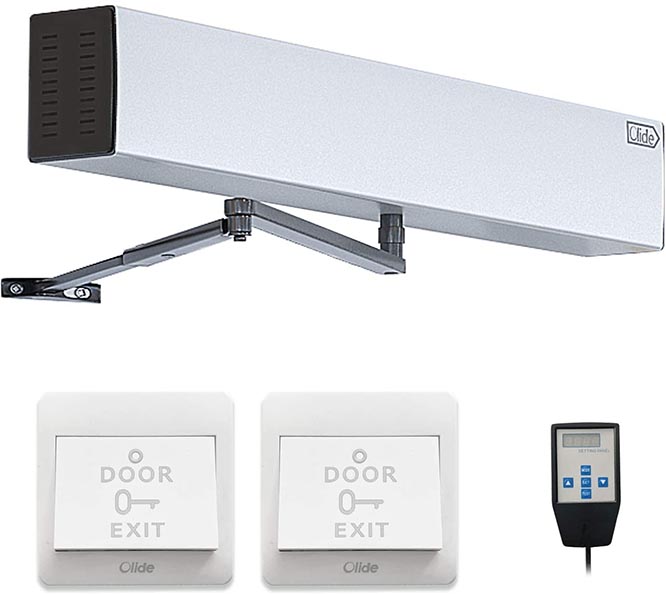
Olide-120B Automatic Door Operator
The Olide-120B Automatic Door Operator consists primarily of a large motor that mounts on your wall above your door. It has a robust design, with a rectangular stainless steel housing that blends into an office environment. The end plates are a black plastic, and the only branding is a small black “Olide” imprint on the front. The overall size of the housing is 21.45 inches wide, 3.74 inches tall, and 3.35 inches deep. At 20.9 pounds, it’s heavier than it looks, but that’s to be expected. After all, it has a powerful motor inside!
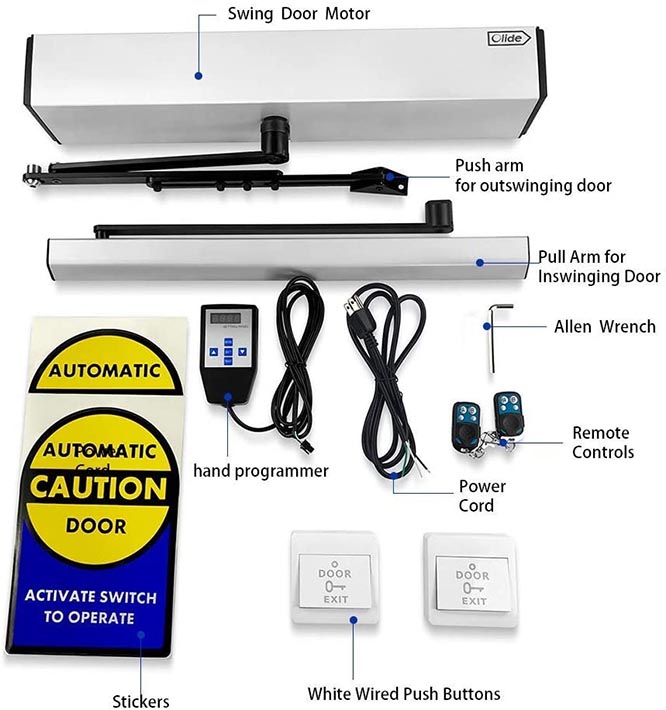
The bottom of the housing has a rotating lug that’s attached to the motor. At the bottom, the lug can be attached to an opening arm. There are actually two different attachments, depending on whether it’s an inswing or an outswing door. The outswing attachment is a simple black metal bar that’s jointed in the center. At the end, there’s a small plate that bolts onto your door. The inswing attachment is a straight metal bar that ends in a wide mounting plate. This plate secures across the width of your door, so it’s secure enough to pull safely. It’s also covered by a wide silver housing, so the screws will be concealed.
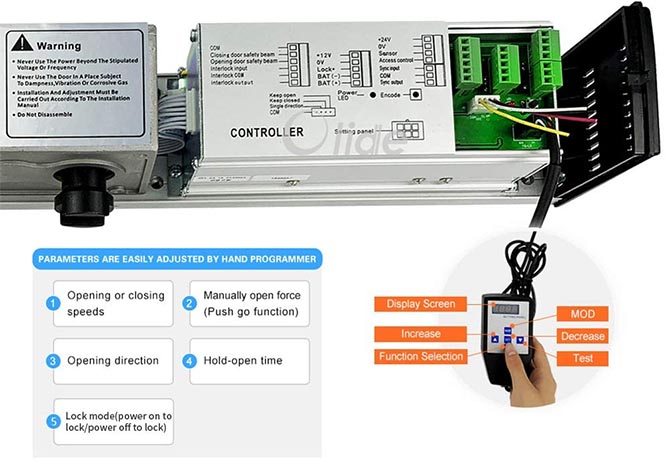
This door opener comes with all the hardware you need for installation. It’s also suitable for installing on a wide variety of doors. For instance, in outswing mode, it will work with up to a 7.87-inch door frame. That’s thicker than standard, which is great news if you’re working in a building with thicker walls. The maximum door width of 47.2 inches is more than sufficient. Most home and office doors max out at 36 inches. This allows you to open large commercial doors that most openers can’t handle. You can even open the door as wide as 120 degrees, which provides better clearance than 90 degrees. Power is supplied by a simple three-prong power cord.
Accessories and Customizability
Along with the opener itself, you get a handful of accessories to get the most out of it. To begin with, there’s a pair of automatic door stickers. These are required by some building codes. And even if they’re not, they alert people that they can open the door automatically. There’s also a pair of white control buttons which you install in the wall on either side. These are hardwired into the opener, and used for manual operation. The buttons are reasonably large, and easy to operate with an elbow if you have to.
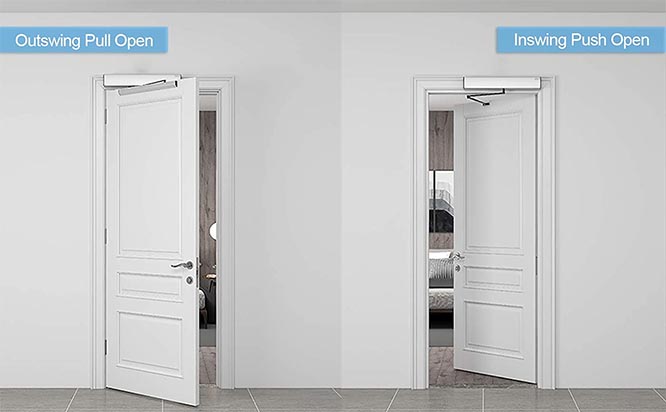
As an alternative, the kit also includes a pair of wireless remotes. These are about the size of a car remote, and they’re small enough to put on your keychain. They have a reasonably long range, but a lot will depend on how much interference you’re getting. Then again, you’ll probably be close to the door to begin with. You can even order extra wireless remotes. In total, up to 15 can be paired with a single door opener.
The last attachment you’ll see is a manual control fob. This fob has a wired lead, and can plug into a lead in the motor housing. When it’s connected, you’ll be able to make a variety of adjustments to the Olide’s performance. You can adjust the amount of time it takes to open the door, from between three and seven seconds. You can adjust how long the door remains open, from 1 to 30 seconds. Last but not least, you can modify the amount of force required for manual opening, to make it harder or easier. The fob is also how you change between inswing and outswing mode.
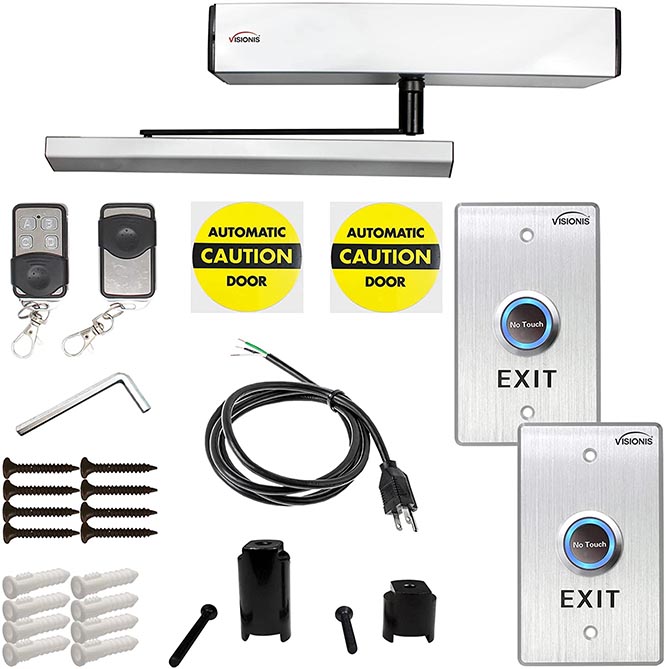
Visionis VIS-7337 Slim
The Visionis VIS-7337 Slim has a slightly more compact design than the Olide opener. The overall size is only 18.7 inches wide, 3.19 inches tall, and 3.86 inches deep. Despite its shorter profile, it weighs almost as much as the Olide, tipping the scales at 18 pounds. The design is comparably plain, though, with a stainless steel finish and black plastic side plates. The only cosmetic touch is a black and red Visionis logo near the bottom left.
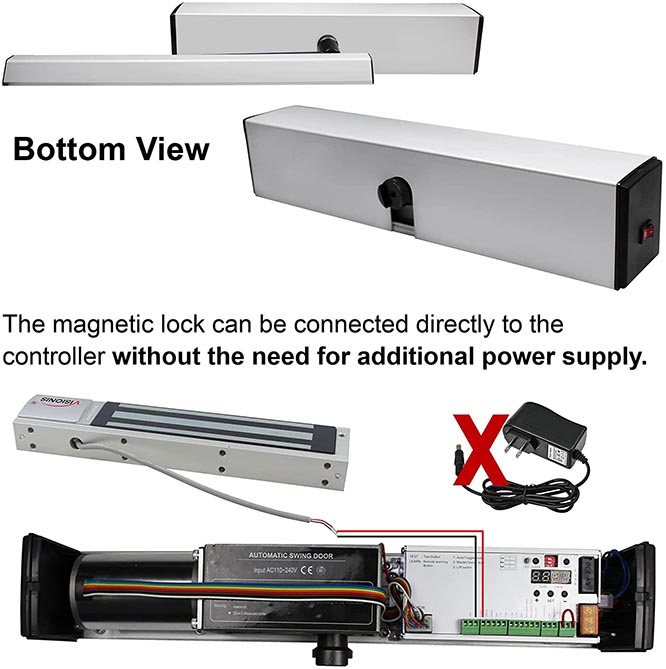
There are six different versions of the VIS-7337 Slim altogether. There are three different control schemes, which we’ll talk about in a second. But all three control schemes are available in either an inswing or an outswing variant. The outswing variant has a jointed black bar, with a little attachment plate at the end. The inswing variant has a longer plate on the end, with a silver cover over it. These bars are basically same as the Olide. The only real difference here is that you pay a little bit less for the VIS-7337, since you only get one bar.
Installation is simple and straightforward. The package includes the screws and anchors you need, along with an M5 Allen wrench for making adjustments. There’s also a 3-prong cord, which plugs into any nearby power outlet. You can also install an electric strike with ease. The wiring setup inside allows you to connect a powered strike, without having to plug the strike into an outlet.
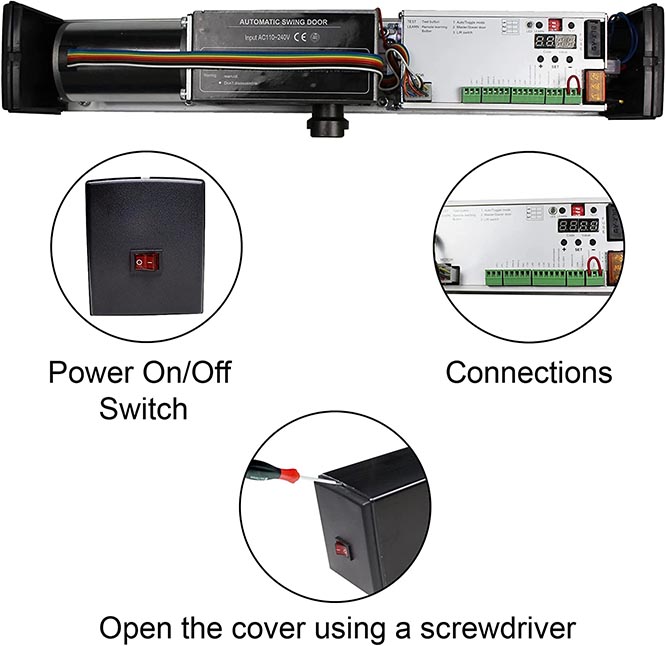
Accessories and Customizability
Each VIS-7337 opener comes with a pair of automatic door stickers. They also include a pair of wireless remotes. These are stainless steel, with a plastic border and blue buttons on the top. They even have a little catch on the back for your keychain. And just like the Olide opener, you can expand to up to 15 remotes in total.
You get fewer adjustment options, but you can still adjust the hold-open time between 0 and 20 seconds. The nice thing is that you don’t have to connect a wired fob or anything like that. Instead, all you have to do is turn the Allen key in the adjustment socket. Manual opening is easy; all you have to do is give it a shove.
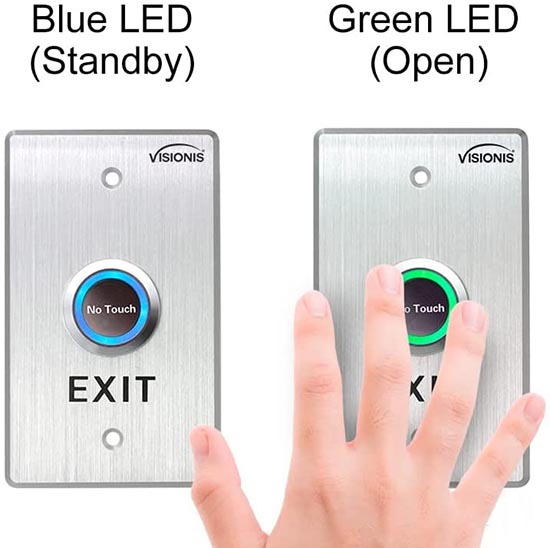
As for the control scheme, you get three different options. The first two are both push buttons, and the difference is basically cosmetic. You can choose between an industrial-style green button, or a more laid-back white button. The third control option is a little bit different. It’s a touch-free sensor, and you wave your hand in front to activate it. The sensor’s range can be adjusted from 5 to 15cm, or about 2 to 6 inches. If you’re concerned about germs, this is a great feature.
Final Verdict
So, which one of these automatic door openers is the right choice for you? The Olide-120B Automatic Door Operator is the most versatile, and can be repurposed as needed. It can also deal with oversized doors and ultra-thick walls.
On the other hand, the Visionis VIS-7337 Slim comes ready for wiring in an electric strike, which is a major convenience. And because it’s one-way only, it’s a little bit more affordable. The hands-free option is another great touch, especially if sanitation is a concern.
Meet Ry, “TechGuru,” a 36-year-old technology enthusiast with a deep passion for tech innovations. With extensive experience, he specializes in gaming hardware and software, and has expertise in gadgets, custom PCs, and audio.
Besides writing about tech and reviewing new products, he enjoys traveling, hiking, and photography. Committed to keeping up with the latest industry trends, he aims to guide readers in making informed tech decisions.

